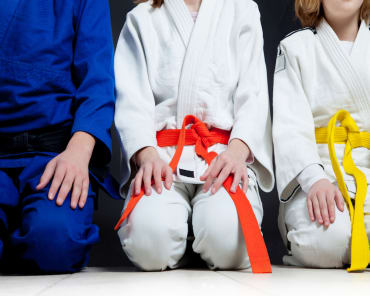
Brazilian Jiu-Jitsu (BJJ) is a martial art built on continuous learning and improvement, with a belt system that reflects a student’s skill level, knowledge, and personal growth. Unlike many other martial arts, BJJ belts are notoriously hard-earned, requiring years of dedication and practice. Each belt signifies more than just the mastery of techniques—it represents mental resilience, growth, and the experience gained on the mats. In this article, we’ll break down the different belts in Brazilian Jiu-Jitsu, explain how students earn them, and what each one signifies along the journey.
1. White Belt: The Beginner
The white belt is where every BJJ student begins. As a white belt, you’re introduced to the basics of Jiu-Jitsu: foundational positions like guard, mount, and side control, as well as core movements such as shrimping, bridging, and simple escapes. This stage is often overwhelming, as there is so much to learn, but it’s also an exciting time where every class presents something new.
A white belt is all about survival. You’re learning how to defend yourself, protect your limbs from submissions, and build the foundation of your Jiu-Jitsu journey. Mistakes and frustration are common, but they’re part of the learning process. At this stage, your primary goal is to absorb as much knowledge as possible and begin to develop an understanding of the sport’s concepts.
How to Earn It: The white belt is given upon starting Jiu-Jitsu, but advancing through white belt to reach blue requires consistent training, mastering basic techniques, and showing an understanding of Jiu-Jitsu principles.
2. Blue Belt: The Knowledge Builder
The blue belt is a significant milestone for any BJJ practitioner. Earning a blue belt typically takes 1-2 years of dedicated training, depending on your gym’s requirements and your individual progression. At this stage, students are expected to have a firm grasp of the basic positions, submissions, and escapes.
As a blue belt, the focus shifts from merely surviving to actively controlling and imposing your game on your training partners. You’ll start to develop your style, gravitating toward certain techniques or positions that suit your body type or strategy. It’s also a time where sparring becomes more comfortable, as you begin to chain techniques together and think several moves ahead.
How to Earn It: To progress to blue belt, students must demonstrate a solid understanding of basic techniques, the ability to apply them during live rolling, and consistent effort on the mats.
3. Purple Belt: The Technician
Purple belt is often considered the “make-or-break” belt in BJJ. It usually takes around 2-4 years of training to reach this level, depending on the individual’s dedication and skill progression. A purple belt practitioner is expected to have an advanced understanding of Jiu-Jitsu techniques, not just in isolation but in combinations and transitions.
At this stage, students are no longer focusing on individual moves but on how to blend them together seamlessly. Purple belts can defend themselves well against less experienced opponents and start to experiment with more advanced submissions, escapes, and sweeps. They also begin to develop a deeper understanding of strategy, timing, and mental discipline.
Many purple belts begin to take on leadership roles in their gyms, helping newer students and sometimes even assisting instructors with classes. It’s a period of both technical refinement and personal growth.
How to Earn It: Earning a purple belt requires mastering a wide range of techniques and the ability to implement them in sparring with both lower and higher-ranked practitioners. Purple belts should show leadership qualities and a commitment to continuous learning.
4. Brown Belt: The Polished Practitioner
The brown belt is the final stage before the coveted black belt and typically takes about 5-7 years of training to achieve. Brown belts are highly skilled practitioners who have refined their techniques to a high degree. By this point, a brown belt should have a well-rounded game with no glaring weaknesses in any particular position.
As a brown belt, your focus shifts toward perfecting your timing, precision, and overall strategy. You’re likely helping other students improve their games, sharing knowledge, and contributing to the gym’s community. This belt is less about learning new techniques and more about mastering the finer details of Jiu-Jitsu—those small adjustments that can make a huge difference in effectiveness.
How to Earn It: A brown belt is awarded to students who have polished their skills, demonstrated leadership within the gym, and shown they’re ready to take the next step toward becoming a black belt.
5. Black Belt: The Expert
Earning a black belt in Brazilian Jiu-Jitsu is a monumental achievement, one that often takes 8-12 years (or more) of dedicated practice. A BJJ black belt is recognized as an expert in the art, having developed a deep understanding of both technique and strategy. But earning a black belt doesn’t signify the end of the journey—it’s the beginning of a new phase of learning.
At this level, black belts focus on further honing their skills, teaching others, and contributing to the growth of Jiu-Jitsu as a martial art. While black belts are highly skilled in all areas of Jiu-Jitsu, they’re also humble enough to recognize that there’s always more to learn. Many black belts continue to train daily, improving their technique and staying sharp.
How to Earn It: Black belts are awarded to students who have demonstrated mastery of Jiu-Jitsu, possess a deep understanding of the art’s concepts, and show leadership both on and off the mats.
Beyond Black Belt: Red and Coral Belts
After earning a black belt, there are additional ranks such as the red and black (coral) belt and eventually the red belt. These belts are reserved for true masters of the art, typically requiring decades of commitment and contributions to the Jiu-Jitsu community. Few practitioners ever reach these levels, but they signify not only technical expertise but also a lifetime of dedication to Brazilian Jiu-Jitsu.
Conclusion
The belt progression in Brazilian Jiu-Jitsu represents much more than just the acquisition of new techniques—it’s a journey of personal growth, mental resilience, and community building. Each belt is a stepping stone, marking a student’s evolution both as a martial artist and as an individual. Whether you’re just starting as a white belt or aiming for the black belt, each step of the journey offers valuable lessons that extend far beyond the mats.






